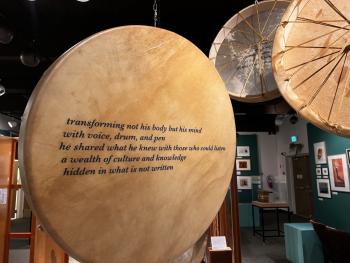Image Caption
Summary
Local Journalism Initiative Reporter
Windspeaker.com
An exhibit that focuses on the life and legacy of a prominent Nuu-chah-nulth artist will have its Vancouver premiere later this month.
The exhibit, titled GEORGE CLUTESI: ḥašaḥʔap / ʔaapḥii / ʕc̓ik / ḥaaʔaksuqƛ / ʔiiḥmisʔap, will open Jan. 20 at the Bill Reid Gallery of Northwest Coast Art. The exhibit will run for a full year, until Jan. 19, 2025.
Clutesi, who died in 1988, was a member of Tseshaht First Nation on Vancouver Island in British Columbia. Besides being an acclaimed artist, Clutesi was also a writer, educator and scholar.
He was instrumental in the education and preservation of Indigenous cultural traditions.
“He was an extremely influential person, probably one of the most well-known Indigenous scholars,” said Tommy Happynook, an assistant professor in anthropology at the University of Victoria.
Happynook said Clutesi established himself in many areas.
“He was a bit of a renaissance man,” said Happynook. “And he was someone who lived in both worlds effectively. He brought Nuu-chah-nulth teachings to non-Indigenous communities with all the work that he did.”
The name of Clutesi’s exhibit is written in the Tseshaht language. The words honour some of his characteristics. In order, the words translated into English mean: keep/protective, generous, talented, strong willed and treasure.
The exhibit had premiered last April in the Vancouver Island city of Port Alberni, which is located on Tseshaht traditional territory, (shared with Hupacasaht, another Nuu-chah-nulth First Nation). Following its year-long run at the Bill Reid Gallery of Northwest Coast Art, the exhibit will then open at Legacy Gallery, located at the University of Victoria, in the spring of 2025.
Clutesi was one of the first Indigenous writers and scholars from his province to write about oral traditions and customs.
Two of his better-known books were titled Potlatch and Son of Raven, Son of Deer, the latter being a collection of fables of the Tseshaht people.
Clutesi also worked at the Alberni Indian Residential School, first as a janitor and then as an educator. He was known for sharing cultural stories, songs and dances with students at the school.
Clutesi’s artwork often featured figures and themes prevalent in Nuu-chah-nulth stories, including whales, thunderbirds, dances, masks and spiritual customs.
The Clutesi exhibit includes 45 pieces of his art, as well as archival clippings, audio recordings, photographs and a documentary about the impact he had at the Alberni Indian Residential School.
“One of the unique parts of the exhibit are audio recordings of George Clutesi speaking,” said Happynook.
“In particular there is a recording of George reflecting on his work a year before he passed away.”
Six other artists who were influenced by Clutesi have also contributed pieces to the exhibit.
Happynook was asked to contribute a piece to the exhibit since he himself is a Nuu-chah-nulth scholar.
“I wanted to have something to show how George inspired myself to direct and incorporate my Nuu-chah-nulth culture into all the things I’m doing at the university,” said Happynook, a member of Huu-ay-aht First Nations.
What Happynook settled on for his piece in the exhibit is a poem titled “The Silent Song In What Was Not Written”.
The text of the poem is screen printed and displayed on four large drums.
The Bill Reid Gallery of Northwest Coast Art, located in downtown Vancouver, is named after Haida artist Bill Reid, who died in in 1998. Reid was a carver, sculptor, goldsmith, writer, broadcaster and spokesman.
The Bill Reid Gallery opened in 2008. It is the only public gallery in Canada devoted to contemporary Indigenous art of the Northwest Coast.
More information about the gallery and the Clutesi exhibit is available at https://www.billreidgallery.ca/
Aliya Boubard, a curator for the gallery, spoke highly of the impacts Clutesi had.
“Like Bill Reid, who also lived and worked in the mid-20th century, George Clutesi was a huge inspiration for the next generation of Nuu-chah-nulth artists and scholars,” she said.
“While they had very different life experiences and approaches to their art forms, these artists helped raise awareness both inside and outside of their communities. George has been instrumental in not only educating others about his community’s cultural traditions, but preserving the sacred stories, dances, and masks that are practiced and celebrated today.”
Support Independent Journalism! SUPPORT US!

